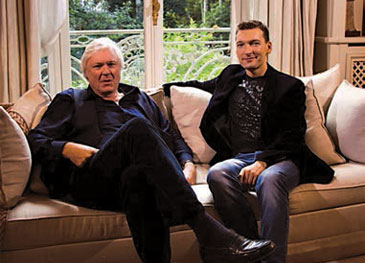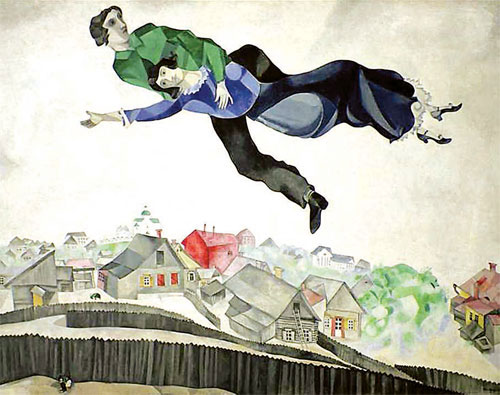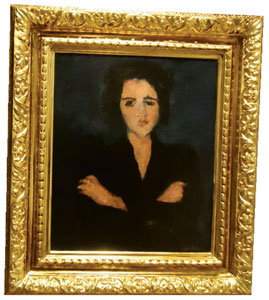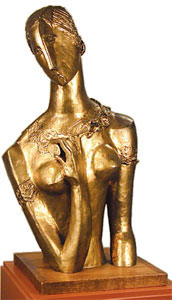It’s become fashionable to investigate our past, delving into family genealogy to fill gaps in our personal history. Famous TV host Oleg Lukashevich is interested not in his own roots but in those of Belarus-born painters who worked in the Parisian School, of France. After a decade of research, he has discovered a great deal and, two years ago, joined Alexander Alexeev in preparing a new documentary series, with an episode devoted to each artist.
 Oleg, few realise that the Parisian School was an international group of painters, which included Picasso, Modigliani and hundreds of other talented painters of various nationalities, who gathered in the French capital in the early 20th century. Belarusians tend only to know about Chagall and Soutine as Belarus-born artists. How have you collected information and what obstacles have you faced?
Oleg, few realise that the Parisian School was an international group of painters, which included Picasso, Modigliani and hundreds of other talented painters of various nationalities, who gathered in the French capital in the early 20th century. Belarusians tend only to know about Chagall and Soutine as Belarus-born artists. How have you collected information and what obstacles have you faced? The National Art Museum has also been researching this sphere but it’s a challenge for them to travel abroad to meet direct descendants and those who hold rights. We’ve conducted a major study of archives, to learn whether any direct descendants of our artists live in Belarus or Russia. In fact, all are scattered abroad. Zarfin’s daughter Liliane gave us a unique photo featuring her father and Michel Kikoпne and you can discover a great deal from diaries and letters.
You’ve shot nine episodes but many more Belarus-born painters are represented within the Parisian School…
Yes, many more. Our original list comprised twelve artists but we lacked enough visual illustrative materials for a full episode for some; several died young, leaving almost no photos or documents. This made it almost impossible to create a full-length episode; you need to show more than their pictures and actors can hardly portray an artiste of whom we know so little (and who lacks descendants). Just four of our painters enjoy global recognition but Ossip Lubitch could worthily rival them, having his own distinct style. I think he’ll be studied more thoroughly in future; it takes time to gain recognition.

Painted by Marc Chagall
How did you learn that these artists lived in a single place at the same time? They were all Jewish and, during the time of Imperial Russia, it was easier for them to receive their education in Paris than in St. Petersburg or Moscow. Late 19th century Paris was full of artists and new trends — including Post-Impressionism. The city was a Mecca for painters, who experienced true freedom of expression.
 What was life like for Belarusian artists in Paris?
What was life like for Belarusian artists in Paris?Only a few received recognition during their lifetime: Chagall, Zadkine and Soutine. Soutine was initially accused of being a ‘shoemaker’ rather than an ‘artist’ so, after he gained recognition — with his pictures selling for up to 22,000 Francs (from an initial 300), he chose to thumb his nose at sceptics. He rented an expensive flat, bought a car and wore fashionable clothes to promenade the Montparnasse. He would pass the local Bohemians and pretend that he had no idea who they were. Recognition in your own lifetime is important, although material wealth also matters; everyone needs to support a family. Most artists lived modestly but not poorly.
Since these artists died long ago, how much truth is there in some of the stories associated with them?
I don’t agree that all the stories are ‘fantasy’. Soutine is the only artist without any direct descendant. However, many people knew him and left first hand recollections. Other painters had children and grandchildren who well remember their talented grandfathers. Interestingly, most of our characters lived long lives: Chagall died at the age of 98 while Lubitch was around 100 on passing. Zarfin and Kikoпne died in the 1960-70s, having enjoyed long lives; their relationships were multitudinous, so we have a great many recollections from those who knew them. These are now valuable documents: part
 of history. Our aim is to create enlightening documentaries, using professional actors to deliver factual-based scripts.
of history. Our aim is to create enlightening documentaries, using professional actors to deliver factual-based scripts.How was Madonna involved in your project? She was the first to watch your documentaries, wasn’t she?
I believe that music is vital to any film, so I chose our soundtrack carefully. In 2011, I visited the Venice Festival, where Madonna presented her film ‘We Believe in Love’. I loved the music (composed by Abel Korzhenevsky) and, on launching our project, realised that the melodies would suit our episodes on Chagall and Soutine. Later, we learnt that Madonna’s company owns the rights, rather than the composer, so we requested permission to use them. Madonna herself watched the scenes for which the music was planned, and read about our series, so that she could make an informed decision. We translated the text into English for her and she approved the idea: we have her signature on the agreement.
A character from the Belarus-Born Artists of the School of Paris project:
Nadezhda Khodosevich was a simple Belarusian girl from a remote village. She moved to Smolensk to study, where she saw a magazine featuring a painting by Leger. Nadezhda fell in love with his artistry and decided that she must become his pupil. Eventually, she succeeded — becoming not only his pupil but his wife! After Lйger’s death, she chose not to spend his fortune but to set up the Fernand Lйger Museum, and presented hundreds of copies of his masterpieces to the Belarusian Art Museum in the 1960s, to share his legacy more widely. It was an incredibly generous decision.











